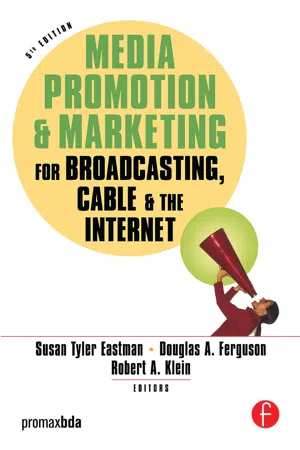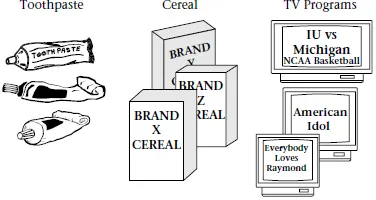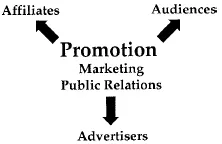![]()
CHAPTER 1
Promoting the Media: Scope and Goals
Susan Tyler Eastman, Douglas A. Ferguson, and Robert A. Klein
Although the field of promotion is part of the larger field of marketing, promotion of electronic media content differs strikingly from marketing of other products. Many excellent textbooks about marketing exist, but most focus on consumer products for sale. They talk about how to use coupons, direct mail, point-of-purchase displays, ties-ins, games and contests, and premiums and incentives to get consumers to buy products — all topics that come up in this book. The key distinction, illustrated in 1.1, is that a particular tube of toothpaste or box of cereal is identical to thousands of other tubes or boxes, whereas, in contrast, every program is unique. Every program is at least slightly different from every other program. Consequently, the promotion of programs differs in a crucial way from the marketing of other products: To be effective, promotion must be specific to that program and even to a series’ individual episodes.
THE SCOPE OF THE BOOK
This book is primarily about promoting programs, including television series and specials. It’s also about promoting radio shows and formats. It’s about how cable systems and cable networks market programs and niche formats to television viewers and advertisers. It’s about promoting the content of streaming media on the Internet and even about promoting video blogs and podcasts.
Promotion of television programs is so important that the commercial media industry forfeits billions of dollars in potential advertising revenue each year to carry promotional messages (promos). Instead of selling every bit of their limited — and oh so very expensive — airtime to advertisers, the hundreds of broadcast and cable networks and the thousands of radio and television stations, as well as groups of local cable systems, give up some of their airtime to put on promos. They also pay other companies to run advertising for their programs (such as in newspapers) and devote the bulk of their websites to promotion of their content. They pay people to create the spots, pages, and advertising, and they lose time and space that could have produced income, merely to invite audiences to watch or listen to their programs. These practices are evidence of program promotion’s indispensable role in retaining and increasing audiences.
THE SPECIAL NATURE OF MEDIA CONTENT
The word programs is commonly associated with television, and the singular nature of most broadcast and cable network programs certainly stands out (or with copycat programs, their lack of specialness stands out). But all electronic media have unique content, and if the media content is preproduced (recorded or prepared in fixed units for live distribution) and intended for large audiences, we can call all such content “media programming.” It is the uniqueness of the individual programs (and separate formats in any single market and of program sites on the web) that gives rise to separate identities for specific content and media companies and thus the need for individualized promotion — both of the program and its source — a network, station, system, or site.
Kinds of Program Content
In the case of television programs, the words used to describe programs signal the amount of uniqueness a viewer should expect. A program can be a series, meaning the characters stay generally the same but the plot varies. Or a program can be a special or an annual special, which means the show is either truly one of a kind or appears on television only once every year (for instance, the Academy Awards or the Super Bowl). Words such as clone, spinoff, and rerun convey the amount of duplication viewers should expect.
In radio — whether the signal is aired by a broadcast station, comes from a satellite program service, or is streamed on the Internet — usually only one station in each market has a particular program format (arrangement of content elements), thus that format is unique to that market.1 At a minimum, small differences always exist between, say, two rock, or two hip-hop, or two country stations in a market, and only larger markets have several stations of the same general format. Nonetheless, even if two or more have the same format, some differences exist in the exact type and proportions of music, local and network news, syndicated shorts, advertising spots, and announcing content. These elements make up the unique identity of a station (or channel), and effective promotion must exploit that uniqueness of identity by creating and maintaining its image.
In media, identity promotion is the same as product branding. When HBO heralds “It’s not TV. It’s HBO,” that represents an effort to establish an identity for the pay network distinct from that of all other entertainment and information services. NBC’s familiar peacock logo, a brand identifier known around the world, appears in 1.2. The niche cable services automatically brand their identities as they promote their individual niches (and woe to the national cable network that can’t communicate its distinctiveness). Individual broadcast stations and local cable channels also identify themselves in ways that show off their uniqueness, which may be a channel’s association with a particular place. For example, the frames from the on-air logo sequence for the Vegas TV Channel in 1.2 explicitly associate the channel with Las Vegas, Nevada.
Unique content appears on the Internet, too. Identity for portals to the Internet has become a function of name and service. GOOGLE is a brand name that is what it does, and widespread use of phrases like “Let’s Google it” is firm evidence of its enormous success (an example of a brand identity becoming a verb). At a lower level, distinct from portals and search engines, and alongside the seemingly infinite variety of nonprogram-related content, the Internet also carries “programs” — channels of streamed audio or video — comparable to radio formats and television programs. Some channels repeat content from other media, such as reruns of old movies or TV shows, live streaming of a radio station, or encores of sporting events. In addition, producers are developing programs wholly original to the Internet, such as local-only sports, experimental shorts of video/audio, and made-for-online movies, some of which make use of the web’s potential for interactivity, others of which — such as video blogging and podcasting — provide opportunities for thousands of amateur voices. New channels and new content need promotion on the air and online to gain large numbers of viewers or listeners.
Moreover, each of the broadcast and cable networks and the big television and radio stations has its own website that promotes its current schedule, with links to specific program sub-sites that combine streamed video and audio with biographies of stars, plot summaries, activities, and so on. Such long-established hits as ER, CSI, and the most current Survivor series, as well as newer ensemble series like Lost, have especially dedicated fans, as do soap operas and sports. Such programs spawn multiple websites, some maintained by media organizations, others by individuals and small groups. Chats and picture sites provide supplements and enhancements for viewers of over-the-air and cable television shows. Such sites are themselves promotion for programs.
In summary, every program on broadcast and cable television requires individual promotion, every format in a radio market requires promotion; every website with original content requires promotion. What appears on the Internet may be promotion for cable or broadcast programming, or it may be unique programming that requires its own promotion. Moreover, radio and television stations and cable networks cross-promote each other (if co-owned) as well as occasionally carry paid advertising that promotes programs on other channels. Indeed, it is sometimes hard to draw a line between these two kinds of messages. Distinction is needed because one costs the carrier money (self-promotion) and one makes money (paid advertising), although promoting a rival may, in the long run, cost more than it makes.
What Promotion Does
Effective promotion draws on the special identity of a program or format to find listeners or viewers. Ultimately, each program must die (get canceled) or live (get renewed) on its own merits, but strategic tools such as advantageous scheduling and large promotional budgets usually boost audience size.
Promotion serves a wide range of functions. It is a tool for attracting new listeners and viewers to programs, extending their listening or viewing, and retaining their listening or viewing over time — from day to day or week to week. It includes talk about new programs and stars on such programs as Entertainment Tonight and on such cable networks as E! Entertainment. Promotion includes on-screen logo-bugs and elaborate radio signatures that remind audiences of the name of the channel being watched or listened to. Frequent reminders are crucial for two reasons: because programs establish a medium’s identity, and in ratings, the right name must be used when audience members fill out diaries so the right channel gets credit for their viewing or listening.
Promotion also comes as topical spots, tickers, bumpers, and next-up titles that encourage viewing or listening to an upcoming program (“Next …”). Considerations in designing such promotional materials are discussed in Chapter 5. Generic information about programs can also function as promotion, which has led all the broadcast and cable networks to create websites intended to amplify fans’ involvement with their on-screen viewing experience. Magazine advertisements, outdoor billboards, and on-air spot promotion are primary tools for drawing attention to a new or improved broadcast or cable or online offering.
Promotion is the way the audience hears about new and ongoing programs, and it influences audience size. The best program in the world will have no audience unless, somehow, people hear about it and learn when and where to hear/see it. Promotion is about that “somehow.”
PROMOTION’S TARGETS
The three main groups for which marketing messages are created are audiences, advertisers, and affiliates, as shown in 1.3. Of these, audiences get the overwhelming portion of attention from promoters of programming and are the focus of this book. Audiences may be either current viewers, listeners, or subscribers or potential viewers, listeners, or subscribers. They may be children, teens, or adults; they may be English-speaking or Spanish-speaking; they may be primarily female or primarily male; they may be green aliens or upside-down-viewing nightworkers!
Audience Messages
Audiences come in as many demographic groups and psychographic (lifestyle) combinations of interests and attitudes as one can imagine. And they may be people who consume mostly one type of music or many formats, watch mostly sitcoms or many kinds of television programming, or want mostly news or mostly entertainment on screen and online. What is important is that the designers of promotion know which subgroup is being targeted in particular pieces of promotion and whole marketing campaigns.
As Chapter 5 points out, one little piece of promotion cannot convey multiple messages and successfully reach very different people.
• At the network level in broadcasting, the most attention goes to audience promotion over-the-air, online, and in print to potential new viewers.
• At the premium cable networks, national audience promotion to retain current subscribers is the current focus.
• At the headquarters of groups of broadcast television and radio stations, local viewers and listeners in a region are the centers of attention.
• At satellite distributors, going after new subscribers remains the primary goal.
• At cable system groups, however, the main goal at present is to convince subscribers to upgrade to digital and broadband services.
All these are different kinds of audiences, and promotion must be designed with different messages that appeal to these different groups of people. The ad for White Sox fans in 1.4 is a generic message from WFLD that both creates and maintains the station’s sports image (using increasingly dirtier socks) while reminding fans where the games can be seen.
Advertiser Messages
In addition to audiences, all entities have to promote to the people that supply the money that supports them. Both commercial and noncommercial media entities promote to their funding sources.
• Commercial media companies devote considerable attention to preparing materials for businesses to sell them advertising time or space. This is called sales promotion.
• In noncommercial television, the corporations supplying grants for producing or airing programs (called underwriters) are the equivalent of advertising targets for promotional messages.
The ad for the Military Channel in 1.5 targets advertisers by pointing out how many millions of households can see the channel and consequently will see the advertising messages it carries.
Similarly, studios and syndicators (distributors of programs) have to prepare promotional materials to aid in the selling of movies and programs to potential affiliates, either in broadcasting or cable. Figure 1.6 illustrates one of the usual ways syndicators commonly appeal to potential program buyers: They compare the ratings performance of a series to similar competing syndicated shows (the buyers’ other choices), and they also explain when the program does best (4 p.m. for Maury) and how much larger an audience it averages over a popular lead-in series.
Although the faces and voices of stars may appear briefly in video, print, and online communications about time/space sales, series buys, or underwriting grants, the key attribute of advertiser and syndicator messages is factual information about audiences, taken from ratings or other research, that responds to the concerns of potential program buyers.
Affiliate Messages
Finally, there are other industry groups (loosely called affiliates) who are ta...






